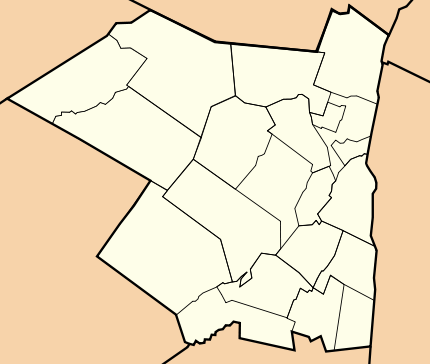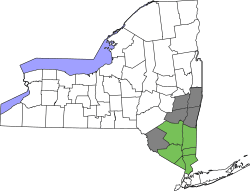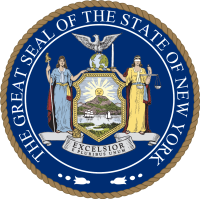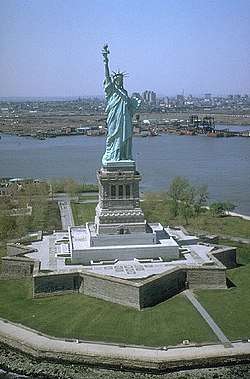Ulster County, New York
Ulster County is a county in the U.S. state of New York. As of the 2010 census, the population was 182,493.[1] The county seat is Kingston.[2] The county is named after the Irish province of Ulster.
Ulster County | |
|---|---|
 The Lake Mohonk Mountain House on Shawangunk Ridge | |
 Flag 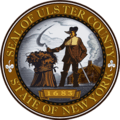 Seal | |
 Location within the U.S. state of New York | |
 New York's location within the U.S. | |
| Coordinates: 41°53′N 74°16′W | |
| Country | |
| State | |
| Founded | 1683 |
| Named for | Ulster |
| Seat | Kingston |
| Largest city | Kingston |
| Government | |
| • County Executive | Patrick K. Ryan |
| Area | |
| • Total | 1,161 sq mi (3,010 km2) |
| • Land | 1,124 sq mi (2,910 km2) |
| • Water | 37 sq mi (100 km2) 3.1% |
| Population (2010) | |
| • Total | 182,493 |
| • Density | 162/sq mi (63/km2) |
| Time zone | UTC−5 (Eastern) |
| • Summer (DST) | UTC−4 (EDT) |
| Congressional district | 19th |
| Website | www |
History
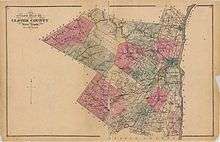
Founding and formation
When part of the New Netherland colony, the area of present-day Ulster County was called "Esopus" by Dutch settlers after the Esopus tribe of the Lenape indigenous people. In 1652, Thomas Chambers, a freeholder from the Manor of Rensselaerswyck, purchased land at Esopus and began trading there. In 1654, Johan de Hulter, owner of 20% of the Killian van Rensselaer Company, was granted a patent which, together with the patents of Christoffel Davids and Jacob Jansen Stoll, supplies evidence of the first permanent European settlement which grew into the village of Wiltwijck, which the English later named Kingston. In 1683, the Duke of York created 12 counties in his province, one of which was Ulster County. Its boundaries at that time included the present Sullivan County and parts of the present Delaware, Orange, and Greene Counties.
In 1777, the first state capital of the independent New York State was established at Kingston. It was moved to Kerhonkson after the British burned Kingston.
In 1797, parts of Otsego and Ulster Counties were split off to create Delaware County.
In 1798, Ulster County's southernmost towns were moved into Orange County to compensate Orange for breaking away its southernmost part to form Rockland County.
In 1800, portions of Albany and Ulster Counties were split off to create Greene County.
In 1809, Sullivan County was split off from Ulster County.
Civil War
During the American Civil War, volunteers were recruited from the county and formed the majority of the following regiments:
- 80th New York Volunteer Infantry Regiment
- 120th New York Volunteer Infantry
- 156th New York Volunteer Infantry
Other regiments with at least one company from the county included:
- 1st Battalion New York Volunteer Sharpshooters
- 1st New York Volunteer Engineer Regiment
- 7th Regiment New York Volunteer Cavalry
- 7th New York Veteran Infantry Regiment
- 15th Regiment New York Volunteer Cavalry
- 20th New York Volunteer Infantry Regiment
- 25th Regiment New York Volunteer Cavalry
- 25th New York Volunteer Infantry Regiment
- 56th New York Volunteer Infantry
- 65th New York Volunteer Infantry
- 71st New York Infantry
- 102nd New York Volunteer Infantry
- 132nd New York Volunteer Infantry Regiment
- 168th New York Volunteer Infantry
- 176th New York Volunteer Infantry
- 178th New York Volunteer Infantry Regiment
- 192nd New York Volunteer Infantry
Twentieth century
The Lake Mohonk Mountain House on Shawangunk Ridge was designated a National Historic Landmark in 1986.[3]
Geography
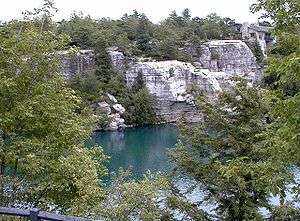
According to the U.S. Census Bureau, the county has an area of 1,161 square miles (3,010 km2), of which 1,124 square miles (2,910 km2) is land and 37 square miles (96 km2) (3.1%) is water.[4]
Ulster County is in southeastern New York State, south of Albany, immediately west of the Hudson River. Much of it is within the Catskill Mountains and the Shawangunk Ridge. Ulster County has Minnewaska State Park, Mohonk Preserve, Sundown State Park, VerNooykill State Forest, Witches Hole State Forest, and Shawangunk Ridge State Forest and Sam's Point Preserve, which includes rare dwarf pine trees and VerKeerderkill falls.
The highest point is Slide Mountain, at approximately 4,180 feet (1,270 m) above sea level. The lowest point is sea level along the Hudson River.
Adjacent counties
- Greene County — north
- Columbia County — northeast
- Dutchess County — southeast
- Orange County — south
- Sullivan County — southwest
- Delaware County — northwest
National protected area
Demographics
| Historical population | |||
|---|---|---|---|
| Census | Pop. | %± | |
| 1790 | 29,370 | — | |
| 1800 | 24,855 | −15.4% | |
| 1810 | 26,576 | 6.9% | |
| 1820 | 30,934 | 16.4% | |
| 1830 | 36,550 | 18.2% | |
| 1840 | 45,822 | 25.4% | |
| 1850 | 59,384 | 29.6% | |
| 1860 | 76,381 | 28.6% | |
| 1870 | 84,075 | 10.1% | |
| 1880 | 85,838 | 2.1% | |
| 1890 | 87,062 | 1.4% | |
| 1900 | 88,422 | 1.6% | |
| 1910 | 91,769 | 3.8% | |
| 1920 | 74,979 | −18.3% | |
| 1930 | 80,155 | 6.9% | |
| 1940 | 87,017 | 8.6% | |
| 1950 | 92,621 | 6.4% | |
| 1960 | 118,804 | 28.3% | |
| 1970 | 141,241 | 18.9% | |
| 1980 | 158,158 | 12.0% | |
| 1990 | 165,304 | 4.5% | |
| 2000 | 177,749 | 7.5% | |
| 2010 | 182,493 | 2.7% | |
| Est. 2019 | 177,573 | [5] | −2.7% |
| U.S. Decennial Census[6] 1790-1960[7] 1900-1990[8] 1990-2000[9] 2010-2019[1] | |||
As of the census[10] of 2010, the county had 181,440 people, 67,499 households, and 43,536 families. The population density was 158 people per square mile (61/km²). There were 77,656 housing units at an average density of 69 per square mile (27/km²). The county's racial makeup, as of 2008, was 83.2% white, 6.50% black or African American, 0.3% Native American, 1.7% Asian, 0.03% Pacific Islander, 2.15% from other races, and 1.70% from two or more races. 7.6% of the population were Hispanic or Latino of any race. 19.2% were of Italian, 16.8% Irish, 15.5% German, 6.8% English, and 4.7% American ancestry according to Census 2000. 90.3% spoke English, 4.5% Spanish, 1.2% Italian, and 1.0% German as their first language.
There were 67,499 households, of which 30.70% had children under age 18 living with them, 49.20% were married couples living together, 10.90% had a female householder with no husband present, and 35.50% were non-families. Of all households, 27.90% were made up of individuals and 10.20% had someone living alone who was 65 years of age or older. The average household size was 2.47 and the average family size was 3.03.
23.50% of the county's population was under age 18, 8.70% was from age 18 to 24, 29.70% was from age 25 to 44, 24.70% was from age 45 to 64, and 13.30% was age 65 or older. The median age was 38 years. For every 100 females, there were 99.10 males. For every 100 females age 18 and over, there were 96.60 males.
The county's median household income was $42,551, and the median family income was $51,708. Males had a median income of $36,808 versus $27,086 for females. The per capita income for the county was $20,846. About 7.20% of families and 11.40% of the population were below the poverty line, including 13.00% of those under age 18 and 8.70% of those age 65 or over.
Government and politics
| Year | Republican | Democratic | Third parties |
|---|---|---|---|
| 2016 | 41.3% 35,239 | 52.3% 44,597 | 6.4% 5,454 |
| 2012 | 37.4% 29,759 | 60.0% 47,752 | 2.7% 2,115 |
| 2008 | 37.4% 33,300 | 60.9% 54,320 | 1.7% 1,529 |
| 2004 | 43.1% 37,821 | 54.3% 47,602 | 2.6% 2,289 |
| 2000 | 42.8% 33,447 | 48.8% 38,162 | 8.5% 6,628 |
| 1996 | 35.5% 26,212 | 48.6% 35,852 | 16.0% 11,787 |
| 1992 | 36.2% 29,223 | 40.7% 32,886 | 23.2% 18,712 |
| 1988 | 56.8% 41,173 | 42.4% 30,744 | 0.9% 640 |
| 1984 | 63.9% 47,372 | 35.7% 26,445 | 0.4% 285 |
| 1980 | 55.0% 36,709 | 33.2% 22,179 | 11.7% 7,838 |
| 1976 | 53.4% 35,353 | 45.6% 30,190 | 0.9% 610 |
| 1972 | 68.5% 46,883 | 31.2% 21,371 | 0.3% 179 |
| 1968 | 57.6% 34,798 | 34.6% 20,886 | 7.8% 4,703 |
| 1964 | 40.0% 23,749 | 59.8% 35,486 | 0.2% 91 |
| 1960 | 61.2% 36,418 | 38.7% 23,017 | 0.1% 67 |
| 1956 | 76.4% 43,034 | 23.6% 13,321 | 0.0% 0 |
| 1952 | 69.4% 36,141 | 30.2% 15,733 | 0.3% 171 |
| 1948 | 64.3% 28,941 | 32.1% 14,441 | 3.6% 1,630 |
| 1944 | 61.0% 26,703 | 38.7% 16,943 | 0.3% 117 |
| 1940 | 57.0% 27,186 | 42.8% 20,403 | 0.2% 107 |
| 1936 | 55.3% 24,678 | 42.9% 19,118 | 1.8% 815 |
| 1932 | 52.9% 21,002 | 45.6% 18,092 | 1.6% 627 |
| 1928 | 62.5% 25,418 | 34.9% 14,200 | 2.7% 1,077 |
| 1924 | 63.3% 20,048 | 29.6% 9,361 | 7.1% 2,251 |
| 1920 | 66.4% 19,001 | 30.6% 8,759 | 3.0% 852 |
| 1916 | 56.6% 10,734 | 41.2% 7,807 | 2.3% 430 |
| 1912 | 38.3% 7,485 | 43.6% 8,510 | 18.1% 3,531 |
| 1908 | 53.1% 10,475 | 43.4% 8,560 | 3.6% 705 |
| 1904 | 53.1% 11,356 | 44.5% 9,516 | 2.3% 501 |
| 1900 | 53.7% 11,348 | 44.2% 9,349 | 2.1% 444 |
| 1896 | 56.3% 11,100 | 41.3% 8,140 | 2.4% 471 |
| 1892 | 46.3% 9,450 | 48.0% 9,808 | 5.7% 1,157 |
| 1888 | 49.6% 10,825 | 48.0% 10,487 | 2.4% 526 |
| 1884 | 48.7% 9,929 | 48.4% 9,870 | 2.9% 586 |
In recent history, Ulster County has voted Democratic. In 2004 John Kerry defeated George W. Bush by 54–43%, in 2008 Barack Obama defeated John McCain by 61–38%, in 2012 Barack Obama defeated Mitt Romney by 60–37%, and in 2016 Hillary Clinton defeated Donald Trump by 52-41%. The county is in New York's 19th congressional district, represented by Democrat Antonio Delgado.
Ulster long had a county-scale version of a council-manager government, with the county legislature hiring a county administrator to handle executive functions. The chair of the legislature had a great deal of power and was accountable only to the voters of his own district. The only countywide elected officials were the district attorney (Holley Carnright has served since 2008) and sheriff (Juan Figueroa took office in 2019).
In 2006, voters approved the first-ever county charter, changing to an elected executive branch. Two years later, Michael P. Hein, the last appointed county administrator, became Ulster's first elected county executive.[12] In early 2019, Hein resigned to accept Governor Andrew Cuomo's appointment as commissioner of the state Office of Temporary and Disability Assistance.[13] Deputy County Executive Adele Reiter succeeded him as acting county executive until a special election was held in April 2019.
On April 30, 2019, Democrat Patrick K. Ryan was elected in a special election by a margin of 74%-26%.[14] He was sworn in as Ulster County's second County Executive on June 7, 2019.[15]
| Name | Party | Term |
|---|---|---|
| Michael P. Hein | Democratic | January 1, 2009 – February 11, 2019 |
| Adele Reiter | Democratic | February 11, 2019 – June 7, 2019 (Acting County Executive) |
| Patrick K. Ryan | Democratic | June 7, 2019 – present (County Executive) |
Legislative authority is vested in the County Legislature, which consists of 23 members elected from individual districts, as directed by a county charter reapportionment mandate starting in late 2010.[16] Of the members of the County Legislature, 12 are part of the Democratic Caucus (11 affiliated with the Democratic Party and 1 unaffiliated), and 11 are part of the Republican Caucus (10 affiliated with the Republican Party and 1 affiliated with the Conservative Party).
| District | Legislator | Party | Residence |
|---|---|---|---|
| 1 | Mary Wawro | Conservative[lower-alpha 1] | Saugerties |
| 2 | Joseph Maloney | Democratic[lower-alpha 2] | Saugerties |
| 3 | Dean Fabiano | Republican | Glasco |
| 4 | James Maloney | Republican | Kingston |
| 5 | Lynn Eckert, Majority Whip | Democratic | Kingston |
| 6 | David Donaldson, Vice Chair | Democratic | Kingston |
| 7 | Brian Woltman | Republican | Kingston |
| 8 | Laura Petit | Democratic | Esopus |
| 9 | Herbert Litts lll | Republican | Highland |
| 10 | Mary Beth Maio | Republican | Highland |
| 11 | Richard Gerentine | Republican | Marlboro |
| 12 | Kevin Roberts | Republican | Plattekill |
| 13 | Kenneth Ronk Jr., Minority Leader | Republican | Wallkill |
| 14 | Craig Lopez, Minority Whip | Republican | Pine Bush |
| 15 | Rev. Julius Collins | Democratic | Ellenville |
| 16 | Tracey Bartels, Chairwoman | Unaffiliated[lower-alpha 3] | Gardiner |
| 17 | James Delaune | Democratic | New Paltz |
| 18 | Heidi Haynes | Republican | Accord |
| 19 | Manna Jo Greene | Democratic | Cottekill |
| 20 | Eve Walter | Democratic | New Paltz |
| 21 | Lynn Archer | Democratic | Accord |
| 22 | Kathy Nolan | Democratic | Shandaken |
| 23 | Jonathan Heppner, Majority Leader | Democratic | Woodstock |
- Mary Wawro is part of the Republican Caucus.
- Joseph Maloney initially was part of the Republican Caucus, then he joined the Democratic Caucus, and then he changed his affiliation to the Democratic Party.
- Tracey Bartels is part of the Democratic Caucus.
Recreation
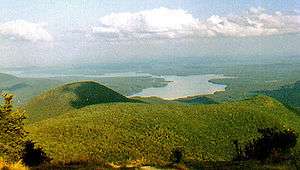
Ulster County contains a large part of Catskill Park and the Catskill Forest Preserve. The former Delaware and Hudson Canal brought Pennsylvania coal to Kingston on the Hudson. Former Orleans band member John Hall served in the Ulster County legislature before moving to the 19th Congressional District to run for Congress.
Ulster County has continued to be a popular vacation destination for many decades. The County is home to many outdoor landscapes, including the Catskill Mountains, the Hudson River, Minnewaska State Park, Catskill Park, Shawangunk Mountains and the Shawangunk Ridge. Each offers various recreation opportunities, including hiking, bicycling, skiing, horseback riding, kayaking, rock climbing, hunting and fishing.
The County also includes more than 40 miles (64 km) of rail trails along the Hudson Valley Rail Trail, Wallkill Valley Rail Trail, and O&W Rail Trail. The Walkway Over the Hudson, the world's longest pedestrian and bicycle bridge which spans the Hudson River, is connected within Ulster County trails.
Ulster County has also played a role in some significant moments in U.S. history. The Senate House State Historic Site in Kingston, New York is where, in early 1777, American colonists met to ratify the New York Constitution.
The Ulster County Fair has been held in New Paltz for many years and is promoted as "The Best Six Days of Summer". County run recreation areas include the Ulster County Pool in New Paltz and the Ulster Landing Park in Saugerties.
Transportation
The New York State Thruway Interstate 87 runs north–south through the county, carrying traffic to and from New York City and its surroundings.
Public transportation in Ulster County is provided by Trailways of New York to and from New York City and Albany, and along Routes 28 and 32, Ulster County Area Transit on major state and US road corridors in the county, and by Kingston Citibus in Kingston.
Communities
City
- Kingston (county seat)
Towns
- Denning
- Esopus
- Gardiner
- Hardenburgh
- Hurley
- Kingston
- Lloyd
- Marbletown
- Marlborough
- New Paltz
- Olive
- Plattekill
- Rochester
- Rosendale
- Saugerties
- Shandaken
- Shawangunk
- Ulster
- Wawarsing
- Woodstock
Villages
Census-designated places
- Accord
- Clintondale
- Cragsmoor
- East Kingston
- Gardiner
- Glasco
- High Falls
- Highland
- Hillside
- Hurley
- Kerhonkson
- Lake Katrine
- Lincoln Park
- Malden-on-Hudson
- Marlboro
- Milton
- Napanoch
- Phoenicia
- Pine Hill
- Plattekill
- Port Ewen
- Rifton
- Rosendale
- Ruby
- Saugerties South
- Shokan
- Stone Ridge
- Tillson
- Walker Valley
- Wallkill
- Watchtower
- West Hurley
- Woodstock
- Zena
Hamlets
See also
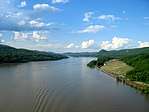
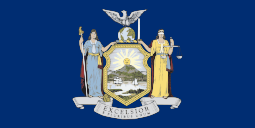
References
- "State & County QuickFacts". United States Census Bureau. Retrieved October 13, 2013.
- "Find a County". National Association of Counties. Retrieved June 7, 2011.
- "National Historic Landmarks Program – Lake Mohonk Mountain House". National Park Service. Archived from the original on November 10, 2013. Retrieved December 7, 2013.
- "2010 Census Gazetteer Files". United States Census Bureau. August 22, 2012. Archived from the original on May 19, 2014. Retrieved January 8, 2015.
- "Population and Housing Unit Estimates". Retrieved May 21, 2020.
- "U.S. Decennial Census". United States Census Bureau. Retrieved January 8, 2015.
- "Historical Census Browser". University of Virginia Library. Retrieved January 8, 2015.
- "Population of Counties by Decennial Census: 1900 to 1990". United States Census Bureau. Retrieved January 8, 2015.
- "Census 2000 PHC-T-4. Ranking Tables for Counties: 1990 and 2000" (PDF). United States Census Bureau. Retrieved January 8, 2015.
- "U.S. Census website". United States Census Bureau. Retrieved January 31, 2008.
- Leip, David. "Dave Leip's Atlas of U.S. Presidential Elections". uselectionatlas.org.
- Brooks, Paul (November 5, 2008). "Hein wins big as first Ulster County executive". Times-Herald Record. Ottaway Community Newspapers. Retrieved November 21, 2008.
- Doxsey, Patricia (January 4, 2019). "Ulster County Executive Michael Hein leaving to take state post". Daily Freeman. Retrieved February 28, 2020.
- Doxsey, Patricia (April 30, 2019). "Democrat Ryan coasts to victory in Ulster County executive special election". Daily Freeman. Retrieved February 28, 2020.
- Doxsey, Patricia (June 7, 2019). "Ryan sworn in as Ulster County executive, promises to lead with 'bold vision'". Daily Freeman. Retrieved February 28, 2020.
- Ulster reapportionment panel to revamp Legislature. DailyFreeman.com. Retrieved on August 9, 2013.
Bibliography
- Clearwater, Alphonso T. (1907). A History of Ulster County, New York. Kingston, NY: W.J. Van Deusen.
- Fried, Marc B. (1975). The Early History of Kingston & Ulster County, NY. Marbletown, NY: Ulster County Historical Society.
- Sylvester, Nathaniel Bartlett (1880). History of Ulster County, New York, with Illustrations and Biographical Sketches of its Prominent Men and Pioneers: Part Second: History of the Towns of Ulster County. Philadelphia, PA: Everts & Peck. OCLC 2385957.CS1 maint: ref=harv (link)
- Ulster County Historians (1984). The History of Ulster County, With Emphasis upon the Last 100 Years, 1883–1983. Kingston, NY: Ulster County Historians. OCLC 11345209.CS1 maint: ref=harv (link)
- Van Buren, Augustus H. (1923). A History of Ulster County Under the Dominion of the Dutch. Kingston, NY. OCLC 1131828.CS1 maint: ref=harv (link)
- Zimm, Louise Hasbrouck (1946). Southeastern New York: A History of the Counties of Ulster, Dutchess, Orange, Rockland and Putnam. New York: Lewis Historical Publishing Co.
External links
| Wikimedia Commons has media related to Ulster County, New York. |
